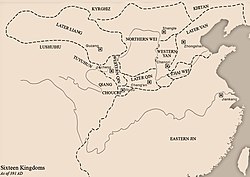Later Yan
Appearance
Later Yan (後燕) 燕 | |||||||||||||
|---|---|---|---|---|---|---|---|---|---|---|---|---|---|
| 384–409 | |||||||||||||
 Later Yan in 391 AD | |||||||||||||
 Later Yan in 398 AD | |||||||||||||
| Capital | Zhongshan (386-397) Longcheng (397-409) | ||||||||||||
| Government | Monarchy | ||||||||||||
| Emperor | |||||||||||||
• 384-396 | Murong Chui | ||||||||||||
• 396-398 | Murong Bao | ||||||||||||
• 398 | Lan Han | ||||||||||||
• 398-401 | Murong Sheng | ||||||||||||
• 401-407 | Murong Xi | ||||||||||||
• 407-409 | Murong Yun | ||||||||||||
| History | |||||||||||||
• Established | 384 | ||||||||||||
• Establishment of Zhongshan as capital | 8 February 386[1][2] | ||||||||||||
• Murong Chui's claim of imperial title | 15 February 386[2][3] | ||||||||||||
• Evacuation of Zhongshan | 27 April 397[4][5] | ||||||||||||
• Murong Xi's death | 16 September 407[6][7] | ||||||||||||
• Disestablished | 6 November[8][9] 409 | ||||||||||||
| |||||||||||||
| Today part of | China | ||||||||||||
The Later Yan (simplified Chinese: 后燕; traditional Chinese: 後燕; pinyin: Hòu Yān; 384-407 or 409) was a Murong–Xianbei state, located in modern-day northeast China, during the era of Sixteen Kingdoms in China.[10]
All rulers of the Later Yan declared themselves "emperors".
Rulers of the Later Yan
| Temple names | Posthumous names | Family names and given name | Durations of reigns | Era names and their according durations |
|---|---|---|---|---|
| Shizu (世祖) | Wucheng (武成) | Murong Chui | 384-396 | Yanwang (燕王) 384-386 Jianxing (建興) 386-396 |
| Liezong (烈宗) | Huimin (惠愍) | Murong Bao | 396-398 | Yongkang (永康) 396-398 |
| – | – | Lan Han | 398 | Qinglong (青龍/青龙) 398 |
| Zhongzong (中宗) | Zhaowu (昭武) | Murong Sheng | 398-401 | Jianping (建平) 398 Changle (長樂) 399-401 |
| – | Zhaowen (昭文) | Murong Xi | 401-407 | Guangshi (光始) 401-406 Jianshi (建始) 407 |
| – | Huiyi (惠懿) | Murong Yun1 or Gao Yun1 |
407-409 | Zhengshi (正始) 407-409 |
| 1 The family name of Gao Yun was changed to Murong when he was adopted by the royal family. If Gao Yun was counted as a ruler of the Later Yan, the state would end in 409. It ended in 407 otherwise. | ||||
See also
References
- ^ "中央研究院網站". www.sinica.edu.tw.
- ^ a b Zizhi Tongjian, vol. 106.
- ^ "中央研究院網站". www.sinica.edu.tw.
- ^ "中央研究院網站". www.sinica.edu.tw.
- ^ Zizhi Tongjian, vol. 109.
- ^ "中央研究院網站". www.sinica.edu.tw.
- ^ Zizhi Tongjian, vol. 114.
- ^ "中央研究院網站". www.sinica.edu.tw.
- ^ Zizhi Tongjian, vol. 115.
- ^ Grousset, Rene (1970). The Empire of the Steppes. Rutgers University Press. pp. 59. ISBN 0-8135-1304-9.
